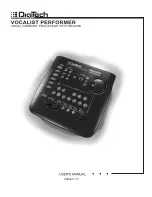
•••
8
•••
Bass (Octave down). This setting produces the same melody as your input voice but in the octave
below. Adding the Bass harmony to your voice produces a sound reminiscent of gospel music.
Adding one of the other harmony choices produces an even bigger sound.
If you want to be the Bass singer in your group but you just can’t sing that low, try adjusting the
Harmony level control all the way to the right. This way you can sing the part in a range you are
comfortable in but the sound will be an octave lower.
Note: There is no need to set key or scale when the Double or Bass voice are the only ones selected.
High and Lower. These are the “smart” voices that produce the 3rd intervals. The High button is a
third above your voice and the Lower button is a 3rd in the octave below. Much of contemporary
popular music features “3rd above” harmony where the main vocal is closely followed in choruses
and selected lines with this harmony. The “3rd in the octave below” harmony produced by the
Lower harmony voice produces a sound reminiscent of the Beatles.
They are referred to as being “smart” because once you tell them what key and scale your song is in,
they will vary their harmony intervals to sound correct over your music. It’s important to pick the
correct key and scale because some notes may sound “offkey” otherwise. See the section on
“Choosing the right key and scale” for more details.
Higher and Low. These voices produce the 5th intervals. The Higher button produces a 5th above
your voice and the Low button produces a 5th in the octave below. The Minor 2 scale is an exeption
where the Low voice is actually a 6th in the octave below and the Lower voice becomes the 5th.
Used by themselves, these voices produce a Gregorian monk type of harmony sound. When used in
conjunction with the High and Lower harmony voices (3rds) you can produce a sound more like the
Eagles or Crosby, Stills and Nash. A fun special effect is to enable only the Low voice and turn the
Harmony mix fully to the right. This can make your talking voice sound a little deeper for announc-
ing and effects.
Choosing Key and Scale
Don’t let the musical terms of key and scale scare you. Just as you tell fellow musicians what key
you’re in before you start into a song, you should tell Performer the same. Though the chords in a
song may change from moment to moment, most songs remain in one key. Determining the key is
usually easy because it often is the first chord in the song. Once you have found the key you can
press the appropriate button on the Performer’s keyboard.
Setting the scale may take a little experimentation. In many of the songs you sing, the difference
may not be noticeable between one Major scale and the next or one Minor scale and the next. This is
because your melody doesn’t land on the one or two altered notes in each scale. If your melody cen-
ters around the root note (an E in the key of E) and maybe the 3rd (G# in E major or G in E minor),
you might not hear any difference between the scales. When you find a song where the melody cen-
ters around the 5th of the scale (B in key of E), the difference becomes more obvious. Instead of
jumping into the theoretical descriptions, let’s try a tutorial.
Summary of Contents for VOCALIST PERFORMER
Page 1: ...Version 1 1 ...
Page 16: ...18 2209 A ...

































